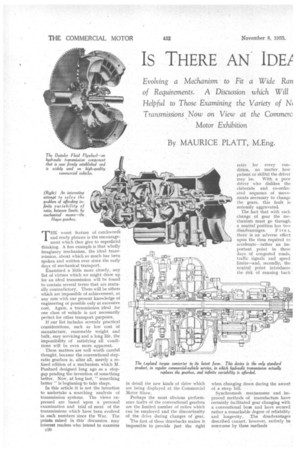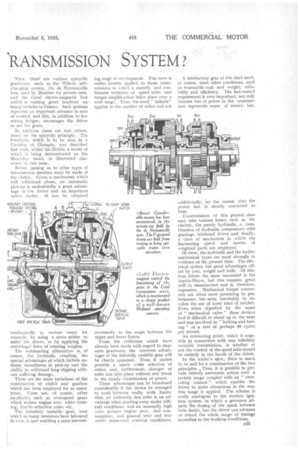Is THERE AN IDEA 1 RANSMISSION SYSTEM?
Page 142

Page 143

If you've noticed an error in this article please click here to report it so we can fix it.
Evolving a Mechanism to Fit a Wide Ran of Requirements. A Discussion which Will Helpful to Those Examining the Variety of N( Transmissions Now on View at the Cornmerci Motor Exhibition
By MAURICE PLATT, M.Eng.
THE worst feature of catchword; and ready phrases is the encouragement which they give to superficial thinking. A fine example is that wholly imaginary mechanism, the ideal transmission, about which so much has been spoken and written ever since the early days of mechanical transport.
Examined a little more closely, any list of virtues which we might draw up for an ideal transmission will be found to contain several terms that are mutually contradictory. There will be others which are impossible of achievement, at any rate with our present knowledge of engineering or possible only at excessive cost. Again, a transmission ideal for one class of vehicle is not necessarily perfect for other transport purposes.
If our list includes severely practical considerations, such as low cost of manufacture, reaSonable weight and bunt, easy servicing and a long life, the impossibility of satisfying all conditions will be even more apparent.
These matters are well worth careful thought, because the conventional stepratio gearbox is, after all, merely a refined edition of a mechanism which M. Panhard designed long ago as a stopgap pending the invention of something better. Now, at long last, "something better" is beginning to take shape.
In this article it is not the intention to undertake a searching analysis of transmission systems. The views expressed are based upon a personal examination and trial of most of the transmissions which have been evolved in such numbers since the War. The pOints raised in this discussion may interest readers who intend to examine a.2.0 in detail the new kinds of drive which are being displayed at the Commercial Motor Show.
Perhaps the most obvious performance faults of the conventional gearbox are the limited number of ratios which can be employed and the discontinuity of the drive during changes of gear.
The first of these drawbacks makes it impossible to provide just the right ratio for every condition, no matter how patient or skilful the driver may be. With a . poor driver who dislikes the elaborate and co-ordinated sequence of movements necessary to change the gears, this fault is seriously aggravated.
The fact that with each change of gear the mechanism must go through a neutral position has two
disadvantages. Firs t, there is an adverse effect upon the time required to accelerate—rather an important, point in these days. of congested roads, traffic signals and speed limits—and, secondly, the neutral point introduces. the risk of running back
when changing down during the ascent of a steep hill.
Synchromesh mechanisms and improved methods of manufacture have certainly facilitated gear changing with a conventional boyin and have secured rather a remarkable degree' ofreliability and longevity. The disadvantages described cannot, however, entirely be overcome by these methods
. Then there' are various epicyclic gearboxes, such as the Wilson selfchauging system, the de Normanville box, used by Humber for private cars, and the Cotal electso-magnetic box which is making great headway on heavy vehicles in France. Such systems represent an important advance in ease of control, and. this, in addition to lessening fatigue, encourages the driver to Use the gears.
In addition there are, two others, based on the epicyclic principle, The Freeborn, which is to be seen in a Crossley at Olympia, was described last week, whilst the Hobbs, a model of which is being demonstrated on the Maudslav stand, is illustrated elsewhere in this issue.
Before passing on to other types of transmission mention must be made of the clutch. Given a mechanism which will withstand abuse, an automatic pick-up is undoubtedly a great advantage to the driver and an important safety factor. It can be obtained mechanically in various ways; for example, by using a servo motor to assist the driver, or by applying the centrifugal force of rotating weights.
The outstanding alternative is, of course, the hydraulic coupling, the special advantages of which include extreme smoothness in pick-up and the ability to withstand long slipping without suffering damage.
These are the main variations of the combination of clutch and gearbox which has been employed for so many years. There are, of course, other auxiliaries such as over-speed gears which reduce engine 'revs, when cruising, double-reduction axles, etc.
The infinitely variable gear, over which so many inventors have laboured in vain, is now reaching a most interest
ing stage of development. This term is rather loosely applied to those transmissions in which a smooth and continuous variation of speed ratio and torque amplification takes place over a wide range. Thus, the word " infinite" applies to the number of ratios and not necessarily to the scope between the upper and lower From the criticisms which have already been made with regard to stepratio gearboxes, the converse advantages of the infinitely variable gear will be clearly apparent. Thus, it makes possible a much wider selection of ratios, and, furthermore, changes of ratio can take place without any break in the steady transmission of power.
These advantages can be broadened considerably if the device be arranged to work between really wide limits; thus, an extremely low ratio is an advantage when starting away under difficult conditions, and an unusually high ratio reduces engine revs., fuel consumption, and general wear and tear uncler main-road cruising conditions. A satisfactory gear of this kind must, of course, meet other conditions, such as reasonable cost and weight, reliability and efficiency. The last-named requirement is very important, not only because loss of power in the ' transmission represents waste of money, but, additionally, for the reason that the power lost is mostly converted to heat.
Transmissions of this general class may take various forms, such as the electric, the purely hydraulic, a com bination of hydraulic components with gearings, frictional drives and, finally, a class of mechanism in which the fluctuating speed and inertia of weighted parts are employed. Of these, the hydraulic and the hydromechanical types are most strongly in evidence at the present time. The elec trical system has great advantages offset by cost, weight and bulk. Of fric tion drives the most successful is the Austin-Hayes, but this requires great skill in manufacture and is, therefore, expensive. Mechanical torque conver ters are often most promising in performance, but seem inevitably to in volve the use of some kind of ratchet.
Even when dignified by the name of " mechanical valve " these devices
find it difficult to stand up to the wear and tear involved in "locking and freeing" at a rate of perhaps SO cycles per second.
An interesting point, Which is arguable in connection with any infinitely variable transmission, is whether or not the control of the speed ratio should be entirely in the hands of the driver. In the writer's view, there is much to be said for a combination of the two principles. Thus, it is possible to pro
vide entirely automatic action over a certain range, coupled with an "over
riding control" which enables the driver to make alterations in the way this range is applied. The scheme is really analogous to the modern ignition system, in which a governor adjusts the timing of the spark between wide limits, but the driver can advance or retard the whole range of timings according to the Working conditions.
• E21












































































































































































































































































































